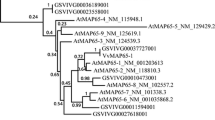Summary
Filamentous structures of 7–10 nm in diameter were regenerated in vitro from a soluble 50 kDa protein (p50) that had been isolated from mung bean seedlings and from cultured tobacco cells. The polymerization of p50 in vitro was dependent on the presence of guanosine nucleotides, in particular, guanosine monophosphate (GMP). Unlike tubulin, p50 is a stable basic protein with the ability to polymerize even after heat treatment for 1 min at 70 °C. Furthermore, the freeze-dried powder of p50 retained the ability to regenerate filamentous structures after it had been dissolved in polymerization buffer to which GMP was then added. Two monoclonal antibodies against p50 were obtained. These antibodies stained the filamentous structures that extended from the surface of the nucleus to the cell periphery in interphase tobacco cells. They stained spindles and phragmoplasts as did tubulin-specific antibodies. They also stained fibrillar structures that were present around the spindle poles and the telophase daughter nuclei in which no microtubules were present. These results suggest that a part of the cell's complement of p50 may be associated with microtubules in dividing cells while the rest may itself form unique fibrillar structures. The antibodies against p50 did not stain cortical microtubules or the pre-prophase band of microtubules. The antibody against p50 also stained intermediate filament-like structures in cultured animal cells. The formation of microtubules in vitro was markedly stimulated and the assembled microtubules were greatly stabilized by p50. Further investigation of p50 is indispensable for the understanding of properties and function of intermediate-sized filaments in higher plant cells.
Similar content being viewed by others
Abbreviations
- EPC:
-
Sepharose ethyl N-phenyl-carbamate conjugated Sepharose
- p50:
-
50 kDa protein
References
Beven A, Guan Y, Peart J, Cooper C, Shaw P (1991) Monoclonal antibodies to plant nuclear matrix reveal intermediate filament-related components within the nucleus. J Cell Sci 98: 293–302
Bottomley RC, Trayer IP (1975) Affinity chromatography of immobilized actin and myosin. Biochem J 149: 365–379
Cyr RJ, Palevitz BA (1989) Microtubule-binding proteins from carrot I. Initial characterization and microtubule bundling. Planta 177: 245–260
Dawson PJ, Hulme JS, Lloyd CW (1985) Monoclonal antibody to intermediate filament antigen cross-reacts with higher plant cells. J Cell Biol 100: 1793–1798
Fisher DZ, Chandhary N, Blobel G (1986) cDNA sequencing of nuclear lamins A and C reveals primary and secondary structural homology to intermediate filament proteins. Proc Natl Acad Sci USA 83: 6450–6454
Goodbody KC, Hargreaves AJ, Lloyd CW (1989) On the distribution of microtubule-associated intermediate filament antigens in plant suspension cells. J Cell Sci 93: 427–438
Hargreaves AJ, Dawson PJ, Butcher GW, Larkins A, Goodbody KC, Lloyd CW (1989a) A monoclonal antibody raised against cytoplasmic fibrillar bundles from carrot cells, and its cross-reaction with animal intermediate filaments. J Cell Sci 92: 371–378
—, Goodbody KC, Lloyd CW (1989b) Reconstitution of intermediate filaments from a higher plant. Biochem J 261: 679–682
Köhler G, Milstein C (1975) Derivation of specific antibody-producing tissue culture and tumour lines by cell fusion. Eur J Immunol 6: 511–519
Laemmli U (1970) Cleavage of structural proteins during the assembly of the head of bacteriophage T4. Nature 227: 680–685
Lazarides E (1982) Intermediate filaments: a chemically heterogenous, developmentally regulated class of proteins. Annu Rev Biochem 51: 219–250
Lloyd CW, Slabas AR, Powell AJ, Peace GW (1983) Novel features of the plant cytoskeleton. Cell Biol Int Rep 6: 171–175
McKeon FM, Kirschner MW, Caputo D (1986) Homologies in both primary and secondary structure between nuclear envelope and intermediate filament proteins. Nature 319: 463–468
McNulty AK, Saunders MJ (1992) Purification and immunological detection of pea nuclear intermediate filaments: evidence for plant nuclear lamins. J Cell Sci 103: 407–414
Mizuno K, Suzaki T (1990) Effects of anti-microtubule drugs on in vitro polymerization of tubulin from mung bean. Bot Mag Tokyo 103: 435–448
—, Koyama M, Shibaoka H (1981) Isolation of plant tubulin from azuki bean epicotyls by ethyl N-phenyl-carbamate-Sepharose affinity chromatography. J Biochem 89: 329–332
—, Sek F, Perkin J, Wick S, Duniec J, Gunning B (1985) Monoclonal antibodies specific to plant tubulin. Protoplasma 129: 100–108
Nagata T, Okada K, Takebe I (1982) Mitotic protoplasts and their infection with tobacco mosaic virus RNA encapsulated in liposome. Plant Cell Rep 1: 250–252
O'Farrell PZ, Goodman HM, O'Farrell PH (1977) High resolution two-dimension electrophoresis of basic as well as acidic proteins. Cell 12: 1133–1142
Parke JM, Miller CJ, Cowell I, Dodson A, Dowding A, Downes M, Duckett JG, Anderton BJ (1987) Monoclonal antibodies against plant proteins recognize animal intermediate filaments. Cell Motil Cytoskeleton 8: 312–323
Powell AJ, Peace GW, Slabas AR, Lloyd CW (1982) The detergent-resistant cytoskeleton of higher plant protoplasts contains nucleus-associated fibrillar bundles in addition to microtubules. J Cell Sci 56: 319–335
Pruss RM, Mirsky R, Raff MC, Thorpe R, Dowding AJ, Anderton BJ (1981) All classes of intermediate filaments share a common antigenic determinant defined by a monoclonal antibody. Cell 27: 419–428
Reynolds ES (1963) The use of lead citrate at high pH as an electron-opaque stain in electron microscopy. J Cell Biol 17: 208–212
Ross JHE, Hutchings A, Butcher GW, Lane EB, Lloyd CW (1991) The intermediate filament-related system of higher plant cells shares an epitope with cytokeratin 8. J Cell Sci 99: 91–98
Spurr AR, Harris WM (1968) Ultrastructure of chloroplasts and chromoplasts inCapsicum annuum I. Thylakoid membrane changes during fruit ripening. Amer J Bot 55: 1210–1224
Steinert P, Zackroff R, Aynardi-Whitman M, Doldman RD (1982) Isolation and characterization of intermediate filaments. Methods Cell Biol 24: 399–419
Wang C, Xing L, Zhai Z (1992) Intermediate filaments in higher plant cells and their assembly in a cell-free system. Protoplasma 171: 44–54
Wick SM, Seagull RW, Osborn M, Weber K, Gunning BES (1981) Immunofluorescence microscopy of organized microtubule arrays in structurally stabilized meristematic plant cells. J Cell Biol 89: 685–690
Author information
Authors and Affiliations
Rights and permissions
About this article
Cite this article
Mizuno, K. A cytoskeletal 50 kDa protein in higher plants that forms intermediate-sized filaments and stabilizes microtubules. Protoplasma 186, 99–112 (1995). https://doi.org/10.1007/BF01276942
Received:
Accepted:
Issue Date:
DOI: https://doi.org/10.1007/BF01276942




